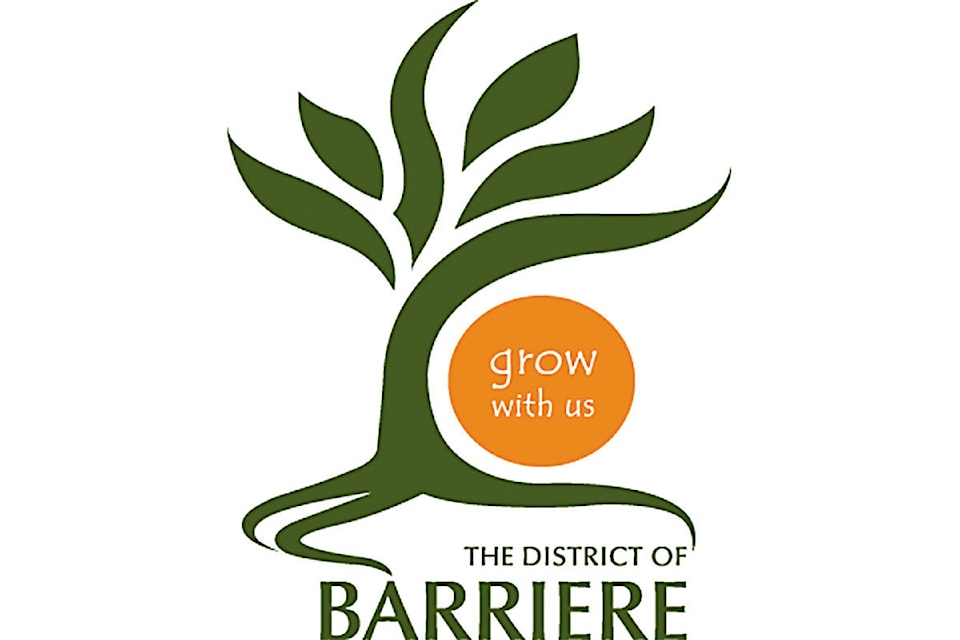The District of Barriere is currently working through the process of getting their new well (PW3) developed advised CAO Bob Payette and Utilities Manager Ian Crosson in an interview last Friday.
“The drilling of the hole went very well, and that took about two weeks,” said the Payette, “The whole district water system is running of the PW1 well right now, and it’s going okay. Over all we’re pretty happy. This has been somewhat of a pilot with PW1, and it has proven to be a nice reliable backup system.”
As originally expected, some discolouration of the water now in the system from PW1 has been noted.
“The discolouration is from the mineral called manganese, and due to a process called oxidization, when the chlorine that is added to the well water reacts with the manganese, it oxidizes and then creates a precipitate. Somewhat like a snow globe at Christmas, it looks all fine and dandy until you shake it up,” said Crosson, “But minerals in the ground water are not as high a content as in surface water, such as the Barriere River.
“The pros to using surface water are large volumes, and the mineral content in the water is a little bit lower. The cons to surface water are the presence of bacteria such as giardia, which can cause giardiasis, or ‘beaver fever’, plus the massive cost of a treatment plant. To have a groundwater source with a treatment plant the cost is about $4.5 million versus a surface water source with a treatment plant that is four times more expensive,” said Crosson, “You would be looking at $20 to $25 million.”
Payette says the casing, the well hole, and the screening is already in place for the new PW3 well.
“They did some test pumping last week and there is good water flow there,” said the CAO, “They also conditioned around the casing for a good filter pack and that seemed to go quite well.”
The next step will be bringing in a specialized company to do a water flow pumping test. That pumping test will determine the final volume or yield that well is going to be able to produce, or in other words, how many gallons can be pumped per minute out of the well.
How long will it take to be able to fully use the new well without causing any damage to it?
“Once we figure out the flow rate and buy the pump, our next steps will be to figure out how we integrate the new well into our current distribution system, through piping, equipment and what not,” said Payette, “And that will take a few months.”
Crosson added that during this process they will be collecting a number of water quality samples, as the key to the new well will be, “what is the quality of water?”
“The water samples are important to do because we know the Bradford Park water quality is sub-par,” said Crosson, “It has elevated mineral levels which cause that discolouration. We know we have some volume at Bradford, but it’s discoloured. If that water was treated we could use that water direct into the system without any issues, and we could then remove Barriere’s Water Quality Advisory that is still in effect with Interior Health. It is key for us to find out with the new PW3 well, what is the water quality? That will then determine if, and what kind of water treatment we would need for it.”
How long before the new well goes into the municipal system?
“We’re thinking this year if everything works out all right,” said Payette, “We still have PW1 and PW2 available for the summer, so we’ll be fine. We want to be careful with this new well so that we get it organized and introduced into the system.”
What does the future hold for the old well that is going to be replaced with PW3?
“There will certainly be a transition period, but at this time we haven’t yet decided if we are going to decommission that well or try and have it as a redundant back up,” said Crosson.
Over the past few months council has been working through a number of bylaw revisions which has resulted in a new fees and charges bylaw for water utilities that is coming out right away. The base rate will remain the same, but there will now be a consumption rate for residential and commercial.
“People should be aware of that and make sure they keep track of their usage so they don’t ramp up their consumption too much,” said the CAO, “We will be monitoring the water meter readings on a monthly basis for every meter in town, and if we see anything getting away on anyone we are going to contact them.”
Crosson noted the amalgamation of the three waterworks bylaws into one has now been completed and residents can now find the new bylaw on the front page of the district’s new website. He emphasized how important it will be for water users to understand the new bylaw because “a number of changes have been made.”
“It’s a large bylaw, it’s lengthy and it has a lot of moving parts to it,” added Payette, “I would recommend that residents have a look at the bylaw and be aware of them.”
You can find the bylaw on the District of Barriere website at: www.barriere.ca, or contact the district at 250-672-9751 to pick up a printed copy.
___________________
Like us on Facebook
